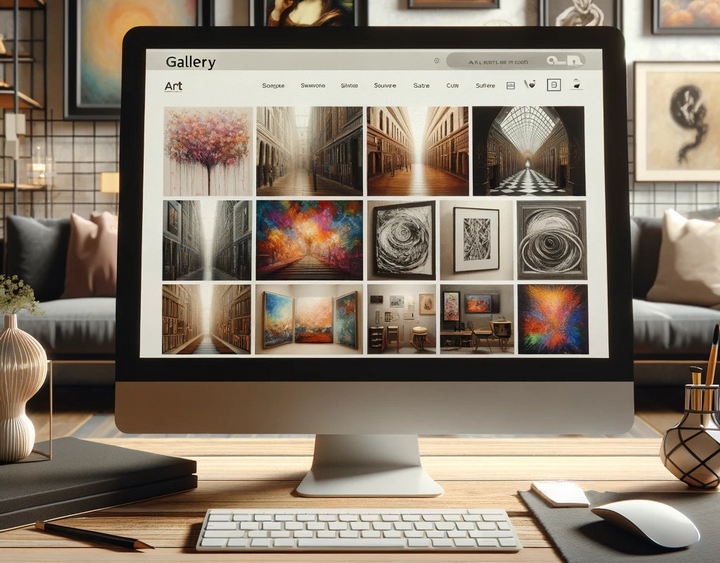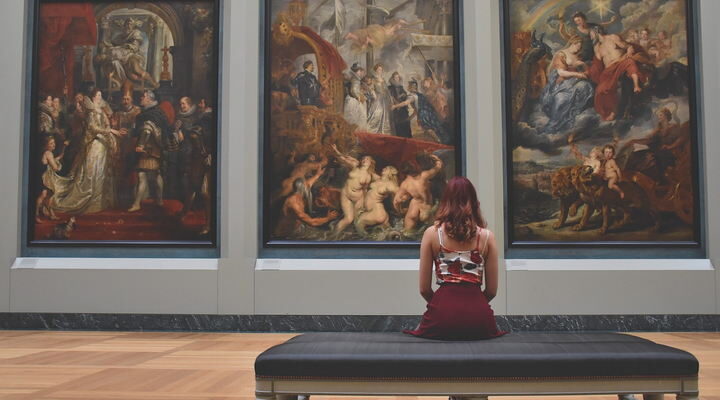In the dynamic world of online art sales, artists have witnessed a rollercoaster of changes lately. With the hit of the pandemic, expectations of a sales slump were high. Yet, online platforms saw a surprising boost. Artists now find themselves in a new era, where digital art showcases and virtual galleries are more crucial than ever.
However, the tide is shifting. As people return to physical stores, artists face the challenge of keeping their online presence strong. It’s not just about creating art anymore; it’s about mastering the art of digital marketing and SEO optimization. This shift calls for innovative strategies to keep your art in the spotlight.
Navigating through social media trends and Google algorithms might seem daunting. But fear not! We’re here to guide you through the essentials. With practical tips and a focus on e-commerce strategies, you’re set to transform your online art venture. Get ready to boost your web traffic, engage more art enthusiasts, and see a real change in your sales figures!
10 – Optimizing Your Art Website for User Experience
Your art website is the digital front of your gallery, where first impressions matter immensely. To make sure visitors stay and explore, focus on a seamless user experience. This means intuitive navigation, fast loading times, and mobile-friendly design. High-quality images of your art are a must, alongside clear, concise descriptions and pricing details. A user-friendly website not only keeps potential buyers engaged but also reflects your professionalism as an artist.
09 – Leveraging Social Media Platforms Effectively
Social media is your digital megaphone, amplifying your art to a broader audience. But it’s not just about posting; it’s about creating a community. Share your creative journey, respond to comments, and engage in meaningful conversations. Utilizing hashtags strategically expands your reach, and collaborating with influencers can introduce your art to new circles. Remember, each platform has its unique flavor, so tailor your content accordingly.
08 – Creating Engaging and Informative Art Blogs
Think of your art blog as a cozy coffee shop where people come to read and relax. Share stories behind your artworks, insights into your creative process, and your take on art trends. Sprinkling in keywords like “modern art techniques” enhances your blog’s SEO, making it easier for art lovers to find you. Regular updates keep your readers hooked and coming back for more of your art world insights.
07 – Utilizing Email Marketing for Direct Engagement
Email marketing is like sending out personalized invites to your art show. It’s direct, personal, and incredibly effective. Grow your email list with enticing offers, and keep in touch with regular updates about your latest works or exclusive previews. Make each email feel like a special note from you to them, and watch as this personal touch converts readers into buyers.
06 – Offering Limited Editions and Exclusive Artwork
Limited editions create a buzz of exclusivity around your work. They’re like the VIP section of your art collection. Offer these special pieces to your most loyal followers first, perhaps through your email list, and make sure to highlight their unique value. Accompany each limited edition with a story or a certificate of authenticity. This not only adds value but also makes each piece an irresistible collectible.

05 – Building a Strong Online Portfolio
Your online portfolio is your art’s digital home, a place where each piece should shine. It’s crucial to select works that showcase your range and skill. Think of it as curating your very own virtual exhibition. Make sure it’s easy to navigate, visually appealing, and tells your story as an artist. A strong portfolio not only captivates your audience but also boosts your online art presence.
04 – Networking with Art Influencers and Bloggers
In the digital art world, connections matter. Reach out to art influencers and bloggers. Collaborating with them can open doors to new audiences. Whether it’s a feature on a popular art blog or a shoutout from an influencer, these partnerships can significantly increase your artwork’s visibility. Remember, it’s about building relationships, not just one-off promotions.
03 – Participating in Online Art Fairs and Exhibitions
Online art fairs and exhibitions are your virtual stage. Participating in these events expands your reach and puts your work in front of a global audience. These platforms are also great for networking with other artists and galleries. Make the most of these opportunities by actively promoting your participation and engaging with visitors. It’s a step towards establishing yourself in the international art community.
02 – Implementing Customer Reviews and Testimonials
Nothing speaks louder than the praise of a satisfied collector. Incorporate customer reviews and testimonials into your website and marketing materials. These endorsements act as trust signals, reassuring potential buyers of your credibility. Encourage your buyers to share their experiences and showcase these stories prominently. It’s a powerful way to build trust and enhance your art brand reputation.
01 – Offering Interactive Virtual Art Experiences
In a world where digital is the new normal, offering interactive virtual art experiences can set you apart. Host live art shows, virtual gallery tours, or interactive Q&A sessions. These experiences engage your audience and create a memorable connection with your art. They’re not just events; they’re unique opportunities to immerse viewers in your creative world, boosting your online art engagement.
Essential SEO Strategies for Artists
In today’s digital art market, SEO (Search Engine Optimization) is not just a fancy term—it’s a necessity. For artists, understanding and applying SEO can be the game-changer in getting their artwork noticed. Here are some key strategies:
-
Understanding SEO:
It’s about making your art easily findable online. This involves using specific keywords related to your art, like “abstract paintings” or “landscape photography,” in all your online content.
-
Anchor Texts and Interlinking:
Anchor texts are clickable phrases in your content that link to other pages. Use these wisely to connect different parts of your website, creating a rich network of content. It’s like showing your visitors around your virtual gallery!
-
Use HTML Tags Smartly:
Tags like headings (H1, H2) and alt texts for images help search engines understand your content better. Think of them as signposts that guide visitors through your website.
-
Meta Descriptions and Titles:
These are your art’s billboards on search engines. Craft them to be catchy and include key phrases like “contemporary art for sale” to attract potential buyers right from the search results.
-
Keyword Strategy:
Keywords are the cornerstone of SEO. Use terms that your potential buyers might search for, such as “oil paintings online” or “digital art prints.” But remember, don’t stuff your content with keywords. Keep it natural!
-
Quality Content:
Regularly update your website with engaging content. This could be blog posts about your creative process or the stories behind your artworks. Quality content keeps visitors coming back and helps improve your search rankings.
-
Backlinks:
These are links from other websites to yours. They act like votes of confidence in the eyes of search engines. Collaborate with art bloggers or participate in online art communities to get these valuable backlinks.
-
Mobile Optimization:
With most art buyers using mobile devices, ensure your website is mobile-friendly. A smooth browsing experience on phones can significantly boost your site’s ranking.
-
Social Media Savvy:
Platforms like Instagram and Pinterest are goldmines for artists. Use them to showcase your work and drive traffic to your website. Remember to use relevant hashtags to increase your visibility.
-
Analyzing Your SEO Performance:
Use tools like Google Analytics to track your website’s performance. Understanding what works and what doesn’t helps you fine-tune your strategy.
By integrating these SEO strategies, you can significantly increase the visibility of your art online. It’s about being seen by the right people at the right time. So, start optimizing today, and watch your online art sales soar!
Adapting to the Evolving Art Market
The art world is ever-evolving, especially online. Adapting to these changes isn’t just a choice; it’s essential for your growth as an artist. Remember, each strategy you apply, from SEO to social media marketing, is a step towards a more vibrant and successful online presence.
You’ve got the creativity, now pair it with smart marketing. Yes, the digital landscape can be overwhelming, but you’re not just an artist; you’re an entrepreneur. Embrace these strategies with the same passion you put into your art. Your unique voice and style deserve a wide audience, and these tips are your toolkit to reach them.
So, take these insights and run with them. Tweak your website, refine your social media approach, and watch your online art sales grow. Stay curious, keep learning, and never hesitate to try new approaches. The digital world is your canvas – paint it with your success!


